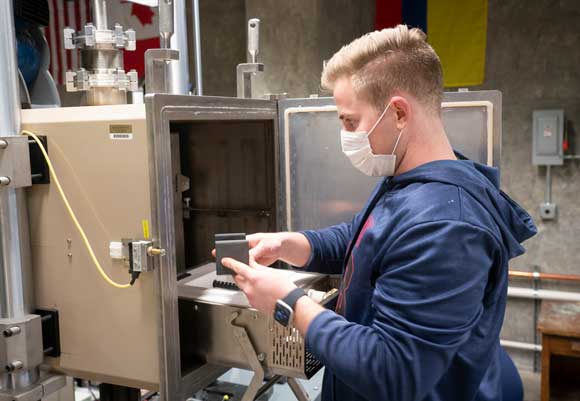Purdue University adds Hypersonics Advanced Manufacturing Technology Center
February 8, 2022

Purdue University, West Lafayette, Indiana, USA, reports that it will expand its hub of hypersonics research by establishing the new Hypersonics Advanced Manufacturing Technology Center (HAMTC). The centre will be focused on developing high-temperature materials and creating new manufacturing processes to build and join these materials, which aims to extend hypersonic vehicles’ capabilities. GE Additive will be the primary partner for Additive Manufacturing at HAMTC, providing AM machines that are customised to processes developed at the facility.
The HAMTC will be a single location at the university to allow industry partners, including GE Additive, Dynetics, Lockheed Martin, Aerojet Rocketdyne, GE Edison Works, Boeing and several small businesses, to work on materials and manufacturing innovations and provide access to testing capabilities at Purdue that are hoped to enable the US to overtake competitors in the field.
The centre will be located in the planned approximately 6000 m2 Hypersonics and Applied Research Facility (HARF), which was established in 2021. In addition to HAMTC, the $41 million HARF facility will house a Mach 8 quiet wind tunnel and the hypersonic pulse (HYPULSE) reflected shock/expansion tunnel.
Air resistance at hypersonic speeds (more than five times the speed of sound) creates extremely hot temperatures, causing surface-level reactions that break down materials.
“When you heat up 3,000ºF [1,648ºC], small differences in expansion can cause large stresses between components made of different materials that may result in failure of hypersonic vehicles,” stated Michael Sangid, executive director of HAMTC and the Elmer F Bruhn Professor of Aeronautics and Astronautics. “At HAMTC, we can essentially increase the temperature capabilities of materials via new compositions, create new manufacturing routes to produce complex geometrical designs, and join these dissimilar materials together, in order to meet the requirements of hypersonic environments.”
HAMTC is the first contract through the Purdue Applied Research Institute (PARI), the university’s new nonprofit applied research arm. OSD Manufacturing Science & Technology Program (MSTP) is partnering with NSWC Crane and National Security Technology Accelerator (NSTXL)’s Strategic & Spectrum Missions Advanced Resilient Trusted Systems (S2MARTS) to address these critical capabilities through advanced manufacturing of hypersonic technologies. PARI received a thirty-month, $18.6 million contract to directly address the hypersonic weapons development gaps.
“The potential and opportunity for Additive Manufacturing in hypersonics is huge,” added Chris Schuppe, general manager – engineering and technology, GE Additive. “We are honoured to be part of Purdue’s team supporting the Department of Defense in manufacturing research that will advance US national security and competitiveness; we value results-driven, industry-academic collaboration in industrialising additive. Our team – many of whom are Purdue alums – are excited to get started.”
Material development and manufacturing at HAMTC offers applications for consumer products and a number of industry applications, including aerospace transportation, green energy, and nuclear applications. The hypersonic aspect also relates to space exploration, particularly vehicles travelling at hypersonic speeds as they re-enter the Earth’s atmosphere.
“What is unique about this is our ability to work hand-in-hand with industry,” Sangid concluded. “We’ll have researchers and students work on real industrial and defence problems, while at the same time advances and transitioning innovations in high temperature materials and cutting-edge Additive Manufacturing.”
















